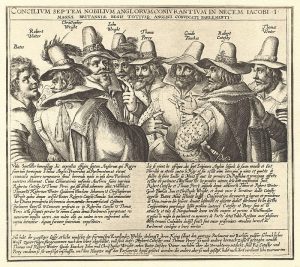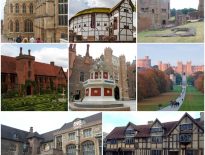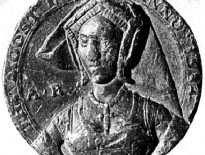 On 27th January 1606, the eight surviving conspirators of the November 1605 Gunpowder Plot were tried at Westminster for high treason. Those tried were Guy Fawkes, Robert and Thomas Wintour (Winter), John Grant, Ambrose Rookwood, Robert Keyes, Thomas Bates and Sir Everard Digby. Jesuits Henry Garnet, Oswald Tesmond (Tesimond) and John Gerard were said to have "traitorously move[d] and persuade[d]" the conspirators. The other conspirators had died shortly after the plot had been discovered; John Wright, Christopher Wright, Thomas Percy and Robert Catesby were shot dead at Holbeche House in a siege on 8th November, and Francis Tresham died in the Tower of London on 23rd December 1605.
On 27th January 1606, the eight surviving conspirators of the November 1605 Gunpowder Plot were tried at Westminster for high treason. Those tried were Guy Fawkes, Robert and Thomas Wintour (Winter), John Grant, Ambrose Rookwood, Robert Keyes, Thomas Bates and Sir Everard Digby. Jesuits Henry Garnet, Oswald Tesmond (Tesimond) and John Gerard were said to have "traitorously move[d] and persuade[d]" the conspirators. The other conspirators had died shortly after the plot had been discovered; John Wright, Christopher Wright, Thomas Percy and Robert Catesby were shot dead at Holbeche House in a siege on 8th November, and Francis Tresham died in the Tower of London on 23rd December 1605.
The conspirators were tried by a commission which included the Earls of Salisbury, Nottingham, Suffolk, Worcester, Devonshire and Northampton, and Sir John Popham acted as Lord Chief Justice. The men all pleaded "Not Guilty" to the charges laid against them which included a plot to:
"First, To deprive the King of his Crown.
Secondly, To murder the King, the Queen, and the Prince.
Thirdly, To stir Rebellion and Sedition in the Kingdom.
Fourthly, To bring a miserable Destruction amongst the Subjects.
Fifthly, To change, alter, and subvert the Religion here established.
Sixthly, To ruinate the State of the Commonwealth, and to bring in Strangers to invade it."
which would be put into effect in the following manner:
"First, The King, the Queen, the Prince, the Lords Spiritual and Temporal, the Knights and Burgesses of the Parliament, should be blown up with Powder.
Secondly, That the whole Royal Issue Male should be destroy'd.
Thirdly, That they would take into their Custody Elizabeth and Mary the King's Daughters, and proclaim the Lady Elizabeth Queen.
Fourthly, That they should feign a Proclamation in the name of Elizabeth, in which no mention should be made of Alteration of Religion, nor that they were Parties to the Treason, until they had raised Power to perform the same; and then to proclaim, All Grievances in the Kingdom should be reformed."
They were all found guilty of treason and sentenced to the "Reward due to Traitors, whose Hearts be hardened", i.e. to be hanged, drawn and quartered:
"For first, after a Traitor hath had his just Trial, and is convicted and attainted, he shall have his Judgement to be drawn to the place of Execution from his Prison, as being not worthy any more to tread upon the Face of the Earth whereof he was made: Also for that he hath been retrograde to Nature, therefore is he drawn backward at a Horse-Tail. And whereas God hath made the Head of Man the highest and most supreme Part, as being his chief Grace and Ornament, Pronaque cum spectent Animalia cætera terram, Os homini sublime dedit; he must be drawn with his Head declining downward, and lying so near the Ground as may be, being thought unfit to take benefit of the common Air. For which Cause also he shall be strangled, being hanged up by the Neck between Heaven and Earth, as deemed unworthy of both, or either; as likewise, that the Eyes of Men may behold, and their Hearts contemn him. Then he is to be cut down alive, and to have his Privy Parts cut off and burnt before his Face, as being unworthily begotten, and unfit to leave any Generation after him. His Bowels and inlay'd Parts taken out and burnt, who inwardly had conceived and harboured in his heart such horrible Treason. After, to have his Head cut off, which had imagined the Mischief. And lastly, his Body to be quartered, and the Quarters set up in some high and eminent Place, to the View and Detestation of Men, and to become a Prey for the Fowls of the Air."
Everard Digby, Robert Wintour, John Grant and Thomas Bates were executed on 30th January 1606 at St Paul's Churchyard. On 31st January 1606, Thomas Wintour, Ambrose Rookwood, Robert Keyes and Guy Fawkes were executed in the same manner at Westminster, in the Old Palace Yard. Henry Garnet was executed on 3rd May 1606. John Gerard managed to flee from England, with the financial support of Elizabeth Vaux, and died a natural death in 1637 at the English College in Rome. Oswald Tesmond also escaped. He fled to Calais pretending to be an owner of a cargo-load of dead pigs. He died in Naples in 1636.
You can read the full details of the trial and the indictments for yourself in A Complete collection of state trials, and proceedings for high-treason, and other crimes and misdemeanours..., Volume 1, p. 258 onwards. This can be read at Google Books at https://books.google.es/books/about/Complete_Collection_of_State_Trials.html?id=nrg-AAAAcAAJ&redir_esc=y or at http://www.armitstead.com/gunpowder/gunpowder_trial.html.
Also on this day in history, 27th January 1596, Sir Francis Drake died of dysentery in Portobelo harbour, Panama - click here to read more.



Loved this article! 🙂